Display world map with country data
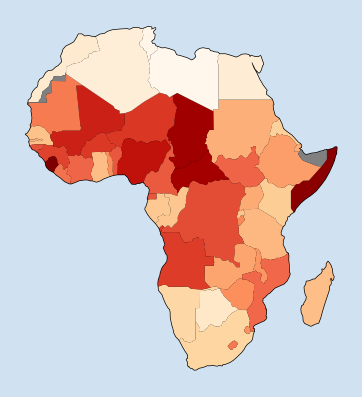
Geographical maps can be a great way to present a global view of where data applies to different countries and regions. There are a number of third-party tools and libraries that can be used to help create these maps such as Basemap, Cartopy as well as Geopandas and Geoplot. This article will show how to use Geopandas to display a world map showing countries with higher Under Five Mortality Rates in darker colors.
Load the data
Details on downloading and loading the Under Five Mortality Rate data into a
dataframe is described in
"Pandas - Load data from Excel file and Display Chart".
The following loads the data from a local file and filters on the Median values
for each country. The ISO.Code field contains the international standard three-letter
code for countries in the world.
1# Load the excel worksheet into a dataframe
2u5mr_df = pd.read_excel(
3 "/tmp/data/Under-five-mortality-rate_2020.xlsx",
4 engine = "openpyxl",
5 sheet_name = 'Country estimates (both sexes)',
6 header = 14,
7 nrows = 585)
8
9# Rename 'Uncertainty.Bounds*' column to 'Uncertainty.Bounds'
10u5mr_df = u5mr_df.rename(columns={'Uncertainty.Bounds*': 'Uncertainty.Bounds'})
11
12# Convert year column names to datetime
13u5mr_df.columns = [x[:-2] if x.endswith('.5') else x for x in u5mr_df.columns]# u5mr_df.columns = [pd.to_datetime(f'{x[:-2]}-12-31') if x.endswith('.5') else x for x in u5mr_df.columns]
14
15# Filter to the Median values
16u5mr_med_df = u5mr_df[u5mr_df['Uncertainty.Bounds'] == 'Median']
17
18# Review the data
19u5mr_med_df.iloc[[0,1,2,3,-4,-3,-2,-1], [0,1,2,3,12,-3,-2,-1]]
20
21"""
22(195, 73)
23 ISO.Code Country.Name Uncertainty.Bounds 1950 1959 2017 2018 2019
241 AFG Afghanistan Median NaN NaN 64.940759 62.541196 60.269399
254 ALB Albania Median NaN NaN 9.418052 9.525133 9.682407
267 DZA Algeria Median NaN 240.344776 24.319482 23.805926 23.256168
2710 AND Andorra Median NaN NaN 3.218925 3.085839 2.966929
28574 VNM Viet Nam Median NaN NaN 20.843125 20.405423 19.935167
29577 YEM Yemen Median NaN NaN 56.966430 58.460003 58.356138
30580 ZMB Zambia Median NaN 208.929172 64.337901 63.294182 61.663465
31583 ZWE Zimbabwe Median NaN 155.256789 58.234924 55.856832 54.612967
32"""
Load Geopandas
Geopandas and Geoplot are required to create these charts. These can be installed
with pip install geopandas and pip install geoplot. Geopandas requires the
Geospatial Data Abstraction Library (GDAL) library to be installed - good instructions
here on How to install GDAL. Geopandas has a dataset for the contours of all the
countries, as well as some information like population estimates, that can be used to
plot the world map and colour countries based on population. The following code loads
the 'naturalearth_lowres' dataset and plots a map with countries colored based on
country population, the darker greens represent higher population. This shows that
China and India dominate this map.
1import geopandas
2import geoplot
3import mapclassify
4
5world = geopandas.read_file(
6 geopandas.datasets.get_path('naturalearth_lowres')
7)
8fig, ax = plt.subplots(figsize = (10,4), facecolor = plt.cm.Blues(.2))
9fig.suptitle('Country Populations',
10 fontsize = 'xx-large',
11 fontweight = 'bold')
12ax.set_facecolor(plt.cm.Blues(.2))
13world.plot(column = 'pop_est',
14 cmap = 'Greens',
15 ax = ax,
16 legend = True)
17
18plt.show()
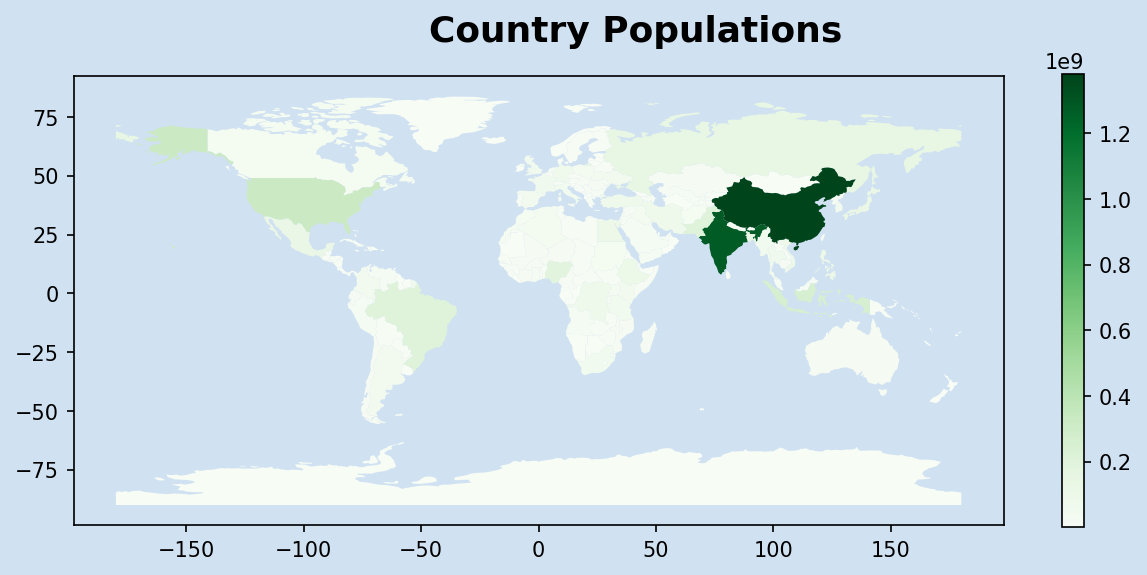
Explore 'naturalearth_lowres' dataset
The 'naturalearth_lowres' dataset is loaded into a Geodataframe, which is a specialised
form of a Pandas Dataframe. So all of the functions and properties of Dataframe apply
to geodataframe. A geodataframe always contains one geoseries called geometry that
holds spatial status.
In the world geodataframe loaded from naturalearth_lowres dataset there are 6 columns and 177 rows.
1type(world)
2"""
3<class 'geopandas.geodataframe.GeoDataFrame'>
4"""
5
6world.shape
7"""
8(177, 6)
9"""
10
11world.columns
12"""
13Index(['pop_est', 'continent', 'name', 'iso_a3', 'gdp_md_est', 'geometry'], dtype='object')
14"""
15
16world.index
17"""
18RangeIndex(start=0, stop=177, step=1)
19"""
20
21world.iloc[[0,1,2,3,-4,-3,-2,-1], :]
22"""
23 pop_est continent name iso_a3 gdp_md_est geometry
240 920938 Oceania Fiji FJI 8374.0 MULTIPOLYGON (((180.00000 -16.06713, 180.00000...
251 53950935 Africa Tanzania TZA 150600.0 POLYGON ((33.90371 -0.95000, 34.07262 -1.05982...
262 603253 Africa W. Sahara ESH 906.5 POLYGON ((-8.66559 27.65643, -8.66512 27.58948...
273 35623680 North America Canada CAN 1674000.0 MULTIPOLYGON (((-122.84000 49.00000, -122.9742...
28173 642550 Europe Montenegro MNE 10610.0 POLYGON ((20.07070 42.58863, 19.80161 42.50009...
29174 1895250 Europe Kosovo -99 18490.0 POLYGON ((20.59025 41.85541, 20.52295 42.21787...
30175 1218208 North America Trinidad and Tobago TTO 43570.0 POLYGON ((-61.68000 10.76000, -61.10500 10.890...
31176 13026129 Africa S. Sudan SSD 20880.0 POLYGON ((30.83385 3.50917, 29.95350 4.17370, ...
32"""
Show countries with population greater than 200 million
1world[(world.pop_est > 200000000)]
2"""
3 pop_est continent name iso_a3 gdp_md_est geometry
44 326625791 North America United States of America USA 18560000.0 MULTIPOLYGON (((-122.84000 49.00000, -120.0000...
58 260580739 Asia Indonesia IDN 3028000.0 MULTIPOLYGON (((141.00021 -2.60015, 141.01706 ...
629 207353391 South America Brazil BRA 3081000.0 POLYGON ((-53.37366 -33.76838, -53.65054 -33.2...
798 1281935911 Asia India IND 8721000.0 POLYGON ((97.32711 28.26158, 97.40256 27.88254...
8102 204924861 Asia Pakistan PAK 988200.0 POLYGON ((77.83745 35.49401, 76.87172 34.65354...
9139 1379302771 Asia China CHN 21140000.0 MULTIPOLYGON (((109.47521 18.19770, 108.65521 ...
10"""
Plot the relative population of countries in Africa. This is done by filtering the dataframe on the continent of 'Africa'
1fig, ax = plt.subplots(figsize = (6,5), facecolor = plt.cm.Blues(.2))
2fig.suptitle('Africa Populations',
3 fontsize = 'xx-large',
4 fontweight = 'bold')
5ax.set_facecolor(plt.cm.Blues(.2))
6ax = world[world.continent == 'Africa'].plot(
7 column = 'pop_est',
8 cmap = 'Greens',
9 ax = ax,
10 legend = True)
11
12plt.show()
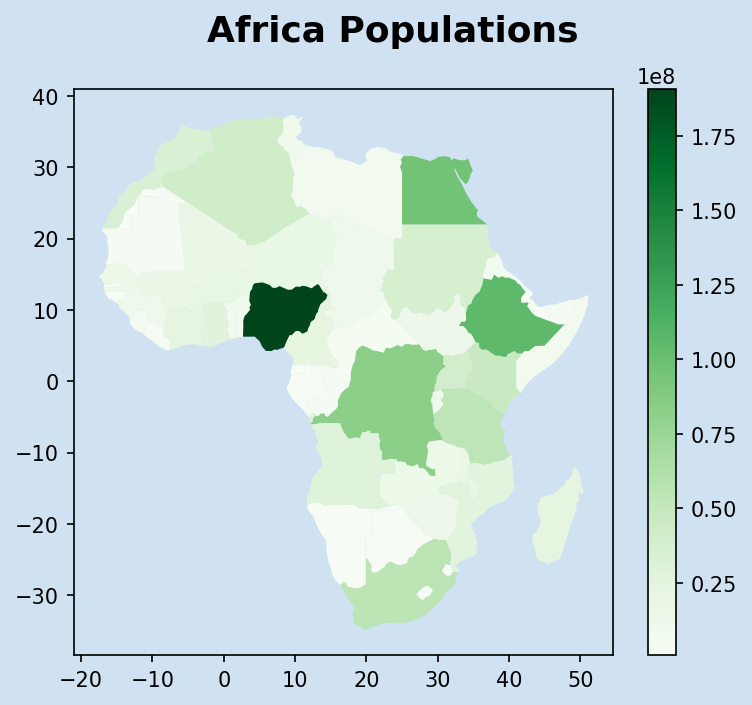
Map of Africa showing country color based on population
Display country color based on Under Five Mortality Rates in 2019
A global map of the Under Five Mortality Rates can be plotted by merging the Under five mortality rates dataframe with the world geodataframe. The merge is done on the ISO country code. There is a discrepancy in the dataframes in that there are 195 countries in the Under Five Mortality Rates dataframe and only 177 countries in the world geodataframe.
1# Countries in ufmr dataframe that are not in the world geodataframe
2u5mr_med_df[~u5mr_med_df['ISO.Code'].isin(list(world['iso_a3']))][['ISO.Code', 'Country.Name']]
3"""
4 ISO.Code Country.Name
510 AND Andorra
616 ATG Antigua and Barbuda
737 BHR Bahrain
843 BRB Barbados
985 CPV Cabo Verde
10112 COM Comoros
11118 COK Cook Islands
12151 DMA Dominica
13187 FRA France
14208 GRD Grenada
15271 KIR Kiribati
16313 MDV Maldives
17319 MLT Malta
18322 MHL Marshall Islands
19328 MUS Mauritius
20334 FSM Micronesia (Federated States of)
21337 MCO Monaco
22358 NRU Nauru
23379 NIU Niue
24382 NOR Norway
25391 PLW Palau
26436 KNA Saint Kitts and Nevis
27439 LCA Saint Lucia
28442 VCT Saint Vincent and the Grenadines
29445 WSM Samoa
30448 SMR San Marino
31451 STP Sao Tome and Principe
32463 SYC Seychelles
33469 SGP Singapore
34526 TON Tonga
35541 TUV Tuvalu
36"""
Show countries that are in the world geodataframe, but not in the Under Five Mortality Rates dataframe.
1# list all countries in World not in ufmr
2world[~world['iso_a3'].isin(list(u5mr_med_df['ISO.Code']))][['iso_a3', 'name']]
3"""
4 iso_a3 name
52 ESH W. Sahara
620 FLK Falkland Is.
721 -99 Norway
822 GRL Greenland
923 ATF Fr. S. Antarctic Lands
1043 -99 France
1145 PRI Puerto Rico
12134 NCL New Caledonia
13140 TWN Taiwan
14159 ATA Antarctica
15160 -99 N. Cyprus
16167 -99 Somaliland
17174 -99 Kosovo
18"""
There are five countries in the world dataframe with iso_a3 code set to "-99". Three of these are disputed or don't yet have an ISO designation. France and Norway have ISO codes of "FRA" and "NOR" respectively and are updated in the geodataframe with the following.
1# Update ISO codes for France and Norway
2world.loc[world.name == 'France', 'iso_a3'] = 'FRA'
3world.loc[world.name == 'Norway', 'iso_a3'] = 'NOR'
Merge the data from Under Five Mortality Rates with the world geodataframe.
The merge is done with an left join on the ISO country code. This reduces the
number of countries to 166 that have both mortality information and geometry information.
Use of a 'left' join keeps all the countries in the original world geodataframe with
the appropriate geometry data. The 11 countries (such as Greenland) that only appear
in the world geodataframe will have NaN for all of the under five mortality rate
data.
1u5mr_world_df = world.merge(u5mr_med_df,
2 left_on = 'iso_a3',
3 right_on = 'ISO.Code',
4 how = 'left')
5u5mr_world_df.shape
6"""
7(177, 79)
8"""
Create a plot showing the under five mortality rates per country for year 2019.
The data in the geopandas.geodataframe can be displayed in a number of ways and it can
be confusing to know which parameter to set. This code creates the same plot in four
different ways. The first three use the plot function on the geodataframe, which uses
matplotlib to generate the plot. The first plot sets a scheme of 'quantiles' for the
choropleth classification scheme, which colors the countries based on discrete intervals.
When choropleth classification scheme of 'quantiles' is used the legend is of type
matplotlib.pyplot.legend so the legend_kwds parameters are different. The default
scheme is None, in which case the legend is of type matplotlib.pyplot.colorbar.
This is used in chart 2 and 3, with the colorbar being changed from vertical to
horizontal. Finally, the fourth plot is rendered using the choropleth function
in geoplot module.
1u5mr_year = u5mr_world_df['2019']
2fig, axs = plt.subplots(
3 nrows = 2,
4 ncols = 2,
5 figsize = (12,5),
6 facecolor = plt.cm.Blues(.2))
7fig.suptitle('National Under Five Mortality Rates in 2019',
8 fontsize = 'xx-large',
9 fontweight = 'bold')
10for ax in axs.flatten():
11 ax.set_facecolor(plt.cm.Blues(.2))
12
13ax1 = axs[0][0]
14u5mr_world_df.plot(
15 ax = ax1,
16 color = 'white',
17 edgecolor = 'black'
18)
19
20u5mr_world_df.plot(
21 column = u5mr_year,
22 scheme = 'quantiles',
23 k = 6,
24 cmap = 'OrRd',
25 ax = ax1,
26 legend = True,
27 legend_kwds = {'title': "UFMR per 1000",
28 'title_fontsize': 'small',
29 'frameon': False,
30 'loc': 'lower center',
31 'bbox_to_anchor': (-0.2, 0.1, 0.5, 1),
32 'fontsize': 'xx-small',
33 },
34)
35[spine.set_visible(False) for spine in ax1.spines.values()]
36ax1.xaxis.set_visible(False)
37ax1.yaxis.set_visible(False)
38
39
40ax2 = axs[0][1]
41u5mr_world_df.plot(
42 ax = ax2,
43 color = 'white',
44 edgecolor = 'black'
45)
46
47u5mr_world_df.plot(
48 column = u5mr_year,
49 cmap = 'OrRd',
50 ax = ax2,
51 legend = True,
52 legend_kwds = {'label': "UFMR per 1000"},
53)
54[spine.set_visible(False) for spine in ax2.spines.values()]
55ax2.xaxis.set_visible(False)
56ax2.yaxis.set_visible(False)
57
58ax3 = axs[1][0]
59u5mr_world_df.plot(
60 ax = ax3,
61 color = 'white',
62 edgecolor = 'black'
63)
64
65u5mr_world_df.plot(
66 column = u5mr_year,
67 cmap = 'OrRd',
68 ax = ax3,
69 legend = True,
70 legend_kwds = {'label': "UFMR per 1000",
71 'orientation': 'horizontal',
72 'shrink': 0.7,
73 },
74)
75[spine.set_visible(False) for spine in ax3.spines.values()]
76ax3.xaxis.set_visible(False)
77ax3.yaxis.set_visible(False)
78
79
80gplt.choropleth(
81 u5mr_world_df,
82 hue = u5mr_year,
83# scheme = scheme,
84 cmap = 'OrRd',
85 ax = axs[1][1],
86 legend = True
87)
88
89plt.show()
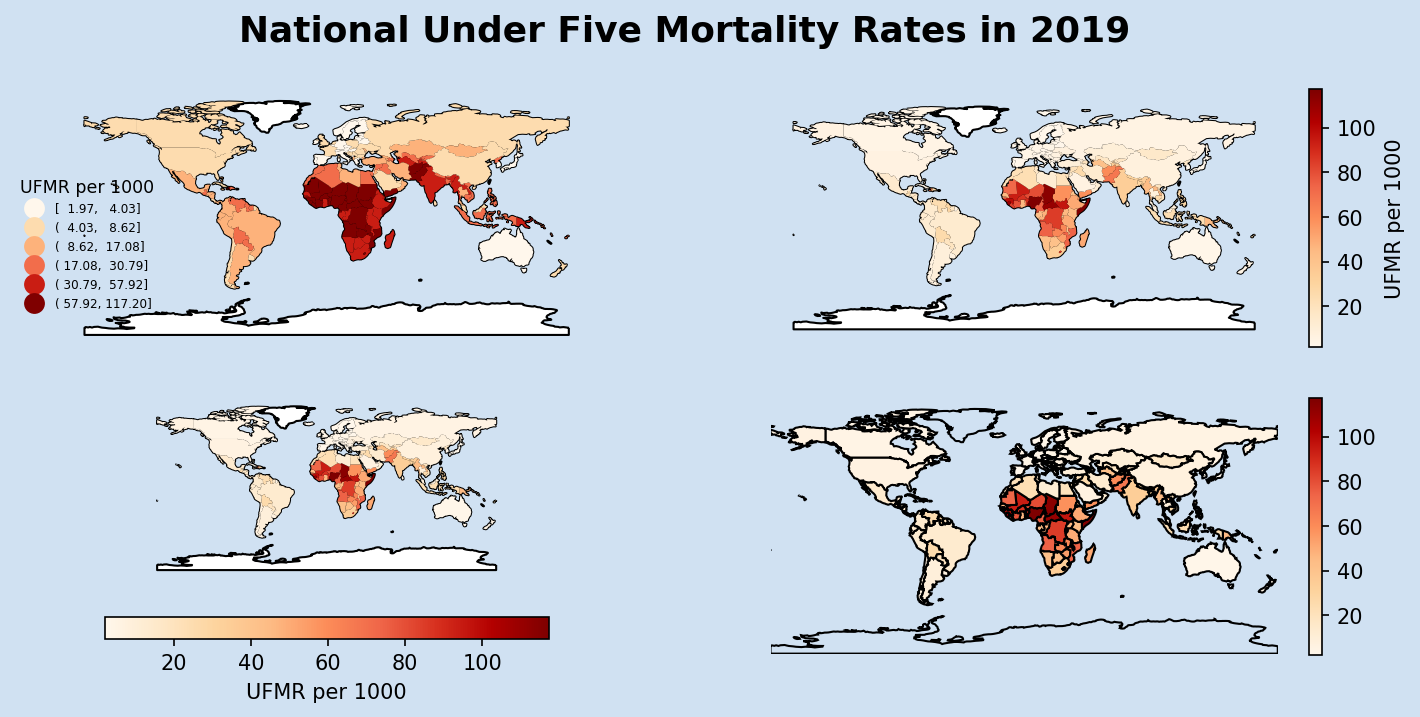
Display country color based on Under Five Mortality Rates in 1985
A function can be created to wrap up the creation of a world map for a particular year
based on option 2 above. A color of gray is added to handle missing data using
misssing_kwds parameter. This is valuable when dealing with earlier years where
there is no data available for many countries and displaying white or no color can
be misleading.
1def create_map_for_year(year, title):
2 u5mr_year = u5mr_world_df[year]
3 fig, ax = plt.subplots(
4 nrows = 1,
5 ncols = 1,
6 figsize = (15,6),
7 facecolor = plt.cm.Blues(.2))
8 fig.suptitle(title,
9 fontsize = 'xx-large',
10 fontweight = 'bold')
11 ax.set_facecolor(plt.cm.Blues(.2))
12
13 u5mr_world_df.plot(
14 ax = ax,
15 color = 'white',
16 edgecolor = 'black'
17 )
18
19 u5mr_world_df.plot(
20 column = u5mr_year,
21 cmap = 'OrRd',
22 ax = ax,
23 legend = True,
24 legend_kwds = {'label': "UFMR per 1000",
25 'shrink': 0.7},
26 missing_kwds = {'facecolor':'Gray'},
27 )
28 [spine.set_visible(False) for spine in ax.spines.values()]
29 ax.xaxis.set_visible(False)
30 ax.yaxis.set_visible(False)
31 return fig
Use the function to create a map for 1985.
1fig = create_map_for_year('1985', 'National Under Five Mortality Rates in 1985')
2plt.show()
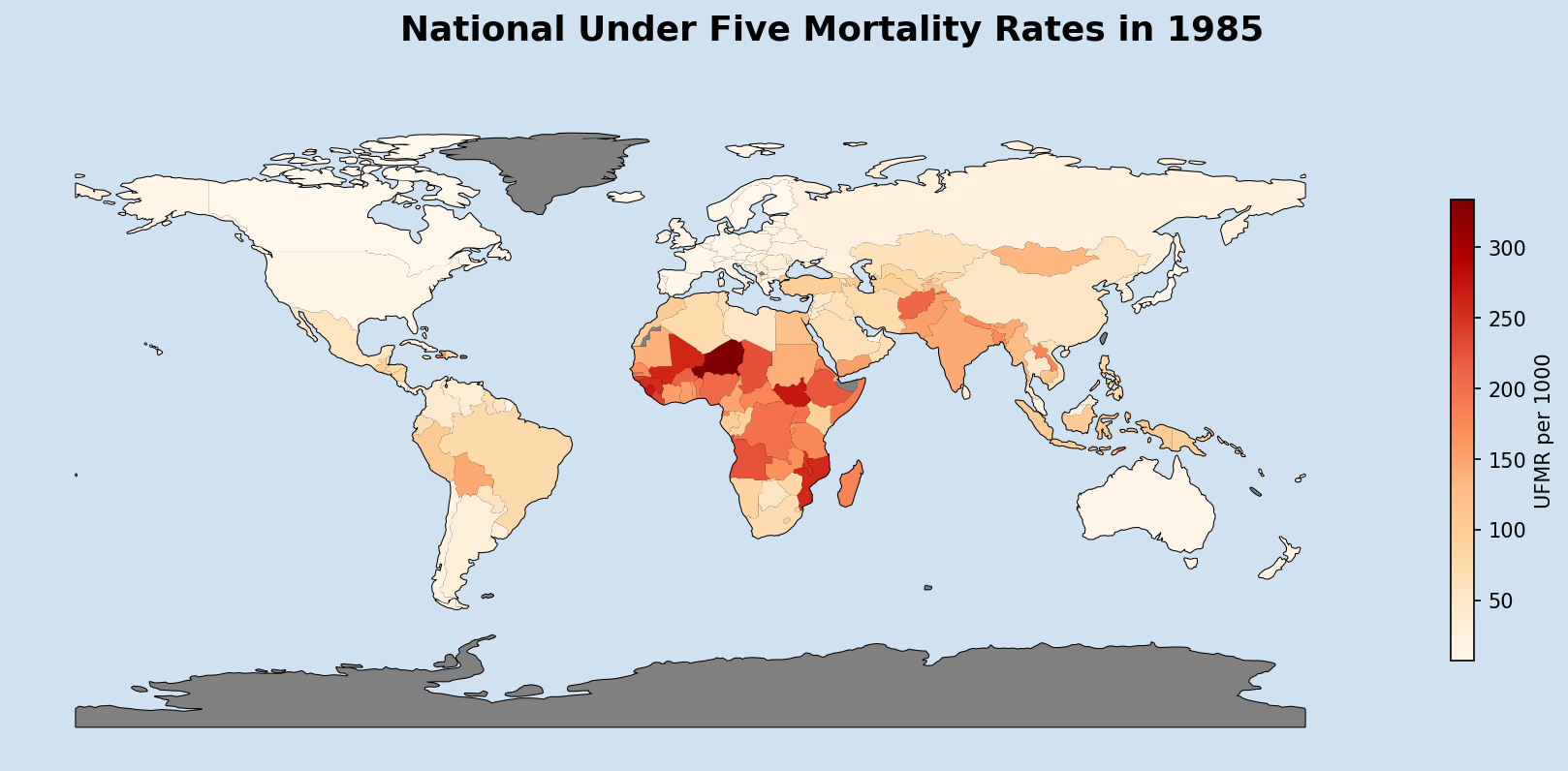
Display changes over the decades
The function is modified to plot a map for an axis.
1def plot_ax_for_year(ax, year):
2 u5mr_year = u5mr_world_df[year]
3 ax.set_title(year,
4 fontsize = 'xx-large',
5 fontweight = 'bold')
6 ax.set_facecolor(plt.cm.Blues(.2))
7
8 u5mr_world_df.plot(
9 ax = ax,
10 color = 'white',
11 edgecolor = 'black'
12 )
13
14 u5mr_world_df.plot(
15 column = u5mr_year,
16 cmap = 'OrRd',
17 ax = ax,
18 legend = True,
19 legend_kwds = {'label': "UFMR per 1000",
20 'shrink': 0.7},
21 missing_kwds = {'facecolor':'Gray'},
22 )
23 [spine.set_visible(False) for spine in ax.spines.values()]
24 ax.xaxis.set_visible(False)
25 ax.yaxis.set_visible(False)
26 return ax
Create a plot with maps through the decades
1fig, axs = plt.subplots(
2 nrows = 4,
3 ncols = 2,
4 figsize = (15,15),
5 facecolor = plt.cm.Blues(.2))
6fig.suptitle('Changes in national Under Five Mortality Rates over time',
7 fontsize = 'xx-large',
8 fontweight = 'bold')
9years = [f'{x}' for x in range(1950, 2020, 10)] + ['2019']
10for i, ax in enumerate(axs.flatten()):
11 ax = plot_ax_for_year(ax, years[i])
12fig.tight_layout(pad=2)
13plt.show()

Conclusion
Geographical maps are a great way to present a global view of where data applies to different countries and regions. Geopandas and Geoplot are used to plot world maps with countries colored based on data of interest. The world maps produced here show the changes over time on Under Five Mortality Rates. This helps visualise particular regions of the world that are consistently doing worse off in addressing child mortality.
Use of Matplotlib creates nice static images, but one drawback of these is precisely that they are static. This data could be more informative if either the maps could be more interactive or displayed as an animation.
Under-five mortality rate:
is the probability of dying between birth and exactly 5 years of age, expressed per 1,000 live births.